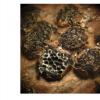
20-12-2025 15:47
Mirek GrycHi.These grew on pine wood that was heavily covere

18-12-2025 21:17
Pol DebaenstThe identification took me to Byssonectria deformi

15-12-2025 07:09
 Danny Newman
Danny Newman
indet. Rutstroemiaceae sp. on unk. fallen leavesMc

19-12-2025 10:10
Patrice TANCHAUDBonjour, récolte réalisée en milieu dunaire, a

18-12-2025 17:23
 Bruno Coué
Bruno Coué
Bonjour,je serais heureux d'avoir votre avis sur c

18-12-2025 18:07
Margot en Geert VullingsThese plumes were found on rotten wood.They strong

17-12-2025 18:35
 Michel Hairaud
Michel Hairaud
Bonjour à tous/Hi to everyone I am passing along

15-12-2025 15:48
 Danny Newman
Danny Newman
Melanospora cf. lagenaria on old, rotting, fallen
Diatrype polycocca on Acer negundo ?
Alex Akulov,
28-09-2013 23:32
 Dear Friends,
Dear Friends,Today on the dead fallen branches of Acer negundo I have collected interesting Diatrype sample, looking like Diatrype polycocca. Asci are 8-sporous, long stipitate, the length of the sporiferous parts are 51-54 (single 70) micrometers, the width - (6.5) 7,1-10,6 micrometers, the length of stipes are 44-70 micrometers. Ascospores allantoid, smoky-brown, 10,9-11,9 x 2.2-2.4 microns.
Did you know this species?
According available at me information, this species was described on Acer opaca from Switzerland and recently was found on Acer platanoides in Poland and on ? Cornus in France.
Waiting for your answer,
Alex
Paul LEROY,
03-10-2013 22:58
Re : Diatrype polycocca on Acer negundo ?
Hello Alex,
Apparemment cette Diatrypaceae pourrait plutôt être: Eutypella leprosa. Cette espèce est
très commune sur arbres feuillus variés et son entostroma blanc conduit plutôt à chercher
vers le genre Diatrype. L'appareil apical est J+ mais est souvent peu visible, même après
prétraitement KOH.
Cordialement
Paul
Apparemment cette Diatrypaceae pourrait plutôt être: Eutypella leprosa. Cette espèce est
très commune sur arbres feuillus variés et son entostroma blanc conduit plutôt à chercher
vers le genre Diatrype. L'appareil apical est J+ mais est souvent peu visible, même après
prétraitement KOH.
Cordialement
Paul
Alex Akulov,
06-10-2013 15:43

Re : Diatrype polycocca on Acer negundo ?
Paul, merci beaucoup pour vos conseils!


